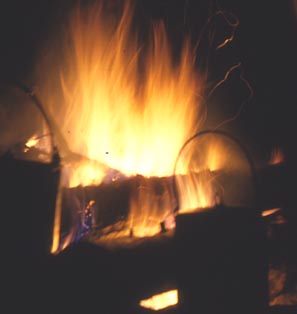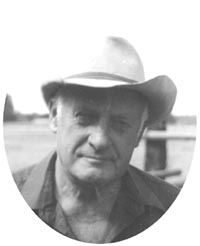a weblog sharing info on outdoor skills and campfire musing by a guy who spends a bunch of time in pursuit of both
CULTURE
WHERE -
TALES ARE TOLD OF
Welcome to Roland Cheek's Weblog
Roland is a gifted writer with a knack for clarifying reality. Looking forward to more of his wisdom
- Carl Hanner e-mail
It is because the vast majority of people do not have the courage to venture off the beaten path that they fail to find adventure, and live lop-sided lives. A good healthy curiosity is better equipment to venture forth than any amount of learning or education. The beaten paths of conformity are literally a prison.
To access Roland's weblog and column archives
Tip o' the Day
There've been dozens of near-unbelievable stories about journeys of domestic animals traveling enormous distances to return to familiar surroundings or explore new ones. So why not wild creatures? Listen to these incredible journeys:
EARL THE ELK - Trapped and radio-collared as a spike bull in the Sweetgrass Hills of northern Montana during late February, 1987. Disappeared from radio survey area within 30 days. Not sighted again until mid-spring of 1990 when reports popped up in northwestern Missouri of a "big mule with horns and wearing a white collar."
Struck by two automobiles while crossing highway. One woman hospitalized. Reported white-collared animal dragged himself from road. Disappeared for two months, then moved into Kansas City suburb. Attracted crowds wherever he went. Authorities decided to trap and remove the animal for public safety. Darted on football field at dawn. Collar itentified him as Sweetgrass elk. Collar returned to Montana, but Earl stayed in Missouri, in a wildlife exclosure just outside Kansas City. [Earl's story is detailed in Roland's book, The Phantom Ghost of Harriet Lou]
GRIZZLY ESCAPE ARTIST -We know exactly how the young female grizzly traveled to southwestern Oregon -- she went there by truck, transported against her will after being judged incorrigibly addicted to breaking and entering camps and foodstocks near a remote wilderness portal. Trapped once and given a second chance, she was released on Ear Mountain, near Choteau. Within days, she'd torn off her radio and crossed the Continental Divide to the scene of her earlier crimes. Trapped again, she was sent to the Oregon wildlife farm.Within months the escape artist was free, having squeezed through a ridiculously tiny gap in a fence that was seven feet from the ground. Subsequent efforts to locate the bear was futile . . . until she bumped up against Oregon black bear hunters and took umbrage at their bear hounds. [Story in detail in Learning To Talk Bear]
TRAVELING WOLF - Then there's the tale about the wolf who originated from a pack that came down from Canada, then didn't stop until he wound up in Wyoming, south of Yellowstone National Park -- before wolves were transplanted there! What prompted the Teton wolf's incredible journey? If you find out, there's a bunch of folks who'd like to know.
HITCHHIKING SALMON - As incredible as the previous journeys seem, nothing matches that of Idaho Salmon smolts on their way to the ocean. In order to avoid being sucked into the plethora of turbines in the Columbia River dams, the young salmon fry are sucked into trucks and transported around the dams.
Somehow juvenile salmon traveling down our highways, instead of down our rivers, seen the most incredible of all.
I have just finished The Phantom Ghost of Harriet Lou. Wow! It was wonderful! I was transported from my stateroom aboard a destroyer to the wilderness I roamed as a teenager. Your tales were well told, enlightening and dead on the money. The open ocean on a calm clear night is beautiful, but I'll never hear the hoarse bellow of a rutting bull. Driving a warship from the bridge into heavy seas and tailing green water is exhulting, but not nearly as much as stumbling across grizzly tracks that haven't begun to fill in. Thank you for sharing with me. My dad sent me the Thursday Great Falls Tribune, no matter where I am in the world for the last 13 years. I have always enjoyed your writing, but this book was special.
TABLE MANNERS FOR BEARS
It must be a tad shocking for a bear to emerge after a long winter's sleep to find their living rooms still locked in a frozen world; kind of like some kind of "April Fool" joke. But up at the elevations most grizzlies spend their hibernation naps, snow--lots of snow--is a given.
One might think it'd profit the bruins to sleep longer. But their biological clocks are set each fall and their alarms ring come spring. It matters little how reluctant Jack Frost might be to leave center stage.
As a rule, male bears emerge before females, and females with cubs of the year last of all. pickings are still slim for the animals in the spring. Unless individual bruins make rich food discoveries such as carcasses of winter-killed wild animals or domestic livestock, or the proceeds from raids on human foodstocks, they will barely hold their own--or even continue to lose weight--until July, when berries begin ripening.
Few creatures in the animal world walk such a perilous food supply tightrope to survival as bears in the spring. Chuck Jonkel, who trained many current bear researchers and is, himself, one of the world's foremost researchers of the family Ursidae, flaltly states:
"Bears really have only two, perhaps two-and-a-half good food months to put on enough fat to take them through winter. Unlike an elk, they can't make up in January for screwing up in July. They're stuck with what they get during that two-and-a-half months."
That's why, according to Dr. Jonkel, that bears are so focused on food--survival dictates such single-minded preoccupation. "I've always said, if finding food was a game of chess, grizzly bears would be the Russians of the world. They'd beat the pants off us."
Most laymen and women would be amazed at the differences between a bear's spring weight and that of the same animal entering its den in the fall: as much as a sixty to eighty percent weight gain. The spring weight of one cinnamon black bear studied by researchers and recounted in my book, Learning To Talk Bear was 163-pounds; the same bear weighed 275-pounds in November. Such gain/loss/gain would be similar to a human swinging between 120-pound anorexia to 200-pound obesity every year--a pattern certain to drive our primary-care doctors to drink something besides cranberry juice.
Yet, for bears, it's a weight swing they must have to survive.
With that background explaining why bruins must forage so voraciously, we begin to see why it's vital that hungry bears not access food in a way that puts them on a collision course with man: garbage, dogfood, horse pellets, seed from bird feeders.
Bear finds sack of dogfood on porch. Bear eats dog food on porch, and probably most of the sack. Bear returns the following evening. No dogfood, but plenty of birdseed to lick up around birdfeeder. Bear trashes birdfeeder in order to get to the heart of the matter. Bear returns the following evening. No dogfood on porch or bird seed at feeder, but molasses-flavored oats in barn. Ad infinitum....
See the pattern? Next farmstead, same thing. Down the road are overflowing garbage dumpsters. On the ridge above yon ranch house is the stockman's "boneyard," where still-born lambs and calves are taken for disposal. Oh yes, and let's not overlook the pen full of hogs, or the beehives in the field by the creek. Soon the bear becomes a nuisance, conditioned to finding food in the presence of humans. At some point, the bear crosses the line from being a nuisance to becoming a danger. Unwittingly, dangerously, we humans have joined the bear in walking the tightrope between ignorance and peril.
I'm part of the problem, and so are you. Given the fact that we're all guilty to some degree, one might conclude that it's remarkable we haven't had more trouble with bears than we've had.
Incidentally, Learning To Talk Bear shares many insights in how to share our place with bears, who, for the most part, are already trying to get along with us.
Roland Cheek wrote a syndicated outdoors column (Wild Trails and Tall Tales) for 21 years. The column was carried in 17 daily and weekly newspapers in two states. In addition, he scripted and broadcast a daily radio show (Trails to Outdoor Adventure) that aired on 75 stations from the Atlantic seaboard to the Pacific Ocean. He's also written upwards of 200 magazine articles and 12 fiction and nonfiction books. For more on Roland, visit:
www.rolandcheek.com
Recent Weblogs
Tuesday, April 1, 2008
There's a bunch of specific info about Roland's books, columns, radio programs and archives. By clicking on the button to the left, one can see Roland's synopsis of each book, read reviews, and even access the first chapter of each of his titles. With Roland's books, there's no reason to buy a "pig in a poke."
for detailed info about each of Roland's books
Read Reviews
Read their first chapters
For interested educators, this weblog is especially applicable for use in history, science, and environmental classes, as well as for journalism students.
Roland, of course, visits schools. For more information on his program alternatives, go to:
NEXT WEEK:
COWERING BEFORE MY DOCTOR
www.campfireculture.com
source links for additional info
to send this weblog to a friend
to tell Roland what you think of his Campfire Culture weblog
to visit Roland's newspaper columns and weblog archives
- Aldo Leopold
Just finished Dance On the Wild Side. It is a wonderful!!! book. Was unable to put it down until I finished it. Want a hardcover Bob Marshall book
In the wonderful, descriptive way Cheek aficionados have come to expect, he brings the bears and other wilderness denizens to life in the reader's imagination. The book is not a documentary. Neither is it a novel. Cheek has simply filled in the blanks with plausible storylines. The animals and events he describes arise from knowledge gained during a life in the mountains observing nature in general, but with concentration on elk and bears.
- Rural Montana
A friend recently loaned me a book to read, saying, "You and this man have a lot in common, and I think you will enjoy this book very much." I told her that I was already reading two books, and that it might be quite a while before I could get yours back to her. That evening I picked up your book My Best Work is Done at the Office, and I was reading it until 2:00 in the morning. I haven't touched my other books since! I just finished this and am about to start Chocolate Legs. My other books can wait. - H. Robert Krear / Estes Park, CO
- Frank Morgan / Willamina, OR
Roland's best selling book, in its 5th printing


